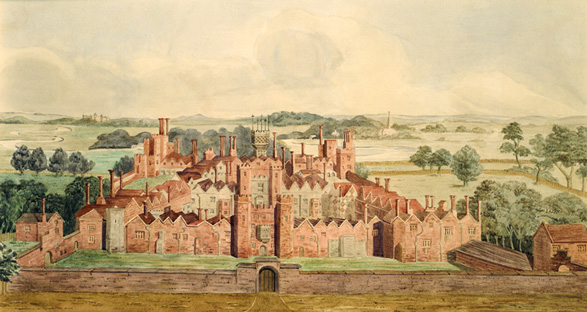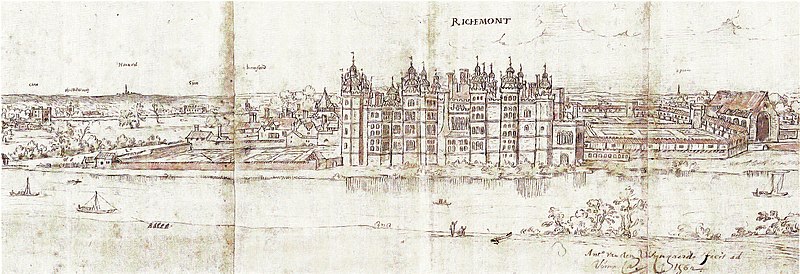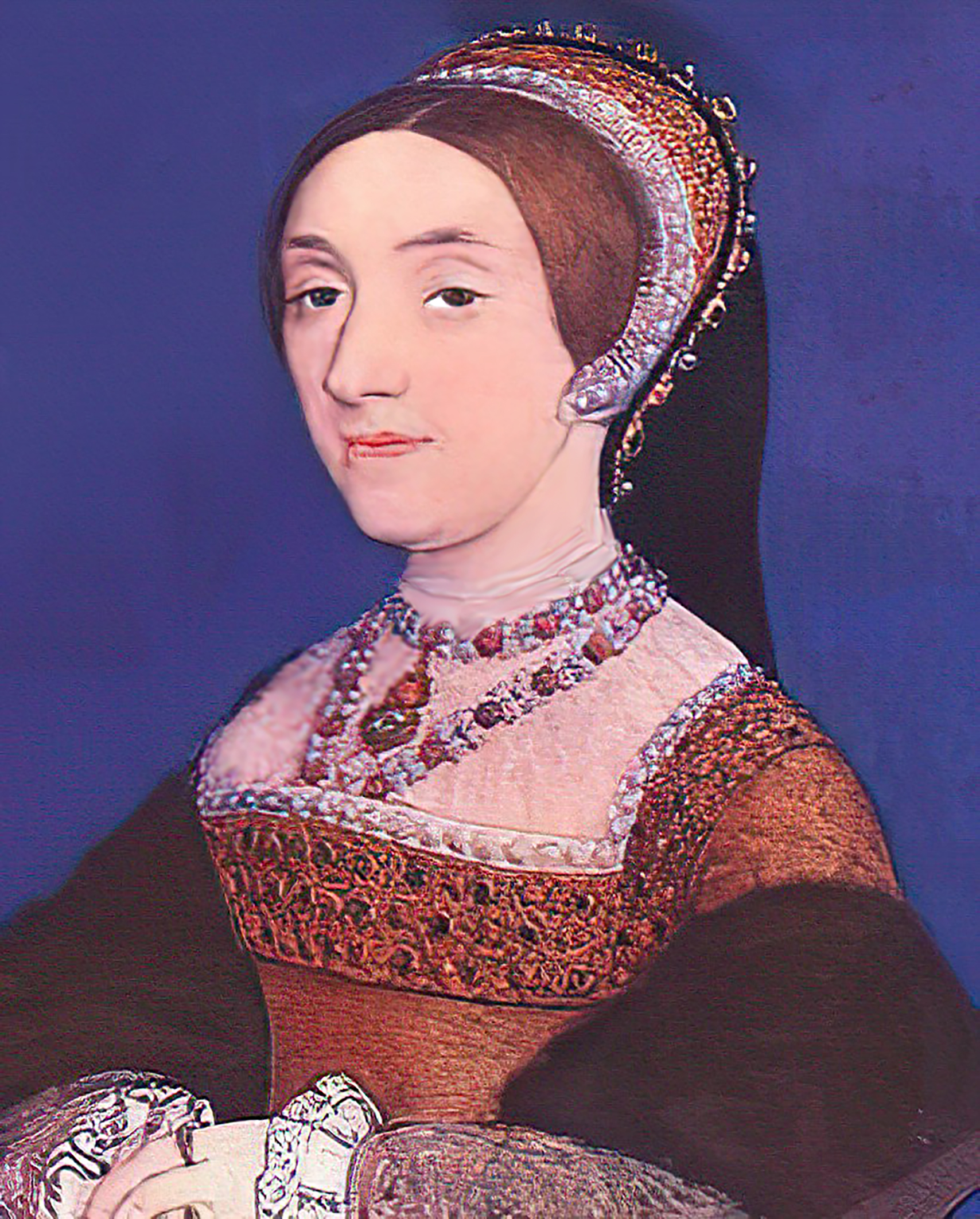 |
| Oatlands Palace |
On the same
day that Thomas Cromwell was executed Henry VIII married his fifth wife, a
former lady-in-waiting of Anne of Cleves, another Catherine, at Oatlands Palace near Weybridge in Surrey. The new queen’s father, Lord Edmund Howard was one of Norfolk’s younger brothers. Both brothers
had pressed Catherine upon the king as a prospective bride.
Henry VIII
is supposed to have ‘cast a fantasy’
towards the petite young girl as soon as he saw her. Catherine was vivacious,
pliable and devoid of guile, very different from her dead cousin Anne. Henry’s
cousin Catherine enjoyed the good life as queen; she was treated as and behaved
as a spoilt child. Henry VIII spent money on her as he had on no other wife.
‘The
King had no wife who made him spend so much money in dresses and jewels as she
did.’[i]
 |
| Arms of the Earl of Sussex |
Along with the dresses, treats and jewels that came her way were
sprinkled favours for her relatives. At court Queen Catherine surrounded herself with old
friends, including the widow of another of Henry’s cousins; Lady Rochford[ii] and a number of people she’d met while living in the household
of the Dowager Duchess of Norfolk, Agnes Tilney.
Mary
Howard was made a member of the queen’s household and Catherine’s brother Charles was made a Gentleman of the Privy Chamber. The Earl of Sussex, Norfolk’s brother-in-law, was made Lord Great Chamberlain, taking over from Cromwell.
On 21st July 1540 Henry was given a purple jacket and doublet
woven with gold and silver tinsel. On 8th September he and his
father were given conjointly the stewardship of Cambridge
University. In November Henry was made a Justice of
the Peace for Norfolk.
The Garter and
a Diversion
I
n April a greater honour was bestowed upon Henry; he was made a Knight of
the Garter in a ceremony at Windsor. He was due to take up his stall on 22nd
May. In between times Henry and Sir Thomas Seymour were sent to France to
observe Sir William Fitzwilliam, the Earl
of Southampton and Lord John
Russell resolve a border dispute between the French garrison at Ardres[iii] and the
English garrison at Guisnes.
 |
| Earl of Southampton |
Both sides massed armies and on 5th May Henry and Thomas
Seymour arrived in Calais, immediately inspecting the fortifications and
mustering men. On the 7th the same was done at Guisnes along with a
military parade. Having shaken a spear in the face of the French, the English
exchanged gifts with the French Governor, Monsieur de Biez. Hunting and dinner
parties were arranged. The French ambassador in London wrote to Paris;
‘Where
nothing but war was talked of there is no mention but of wishing to live at
peace.’[iv]
Henry was back in England in time to shop for his Garter ceremony; he
purchased his mantle, black velvet cap, collar and medallion of St George
without reference to his shaky finances. The gold collar was six troy ounces
more than the maximum provided for by the order’s regulations and his St George
medallion was encrusted with ten diamonds.
 |
| Sheen |
The day before the ceremony Henry was a guest of Edward Seymour at Sheen. Over
dinner, along with his fellow knight-elect Sir John
Gage, Henry was talked through the ceremony he would undergo. The Earl of
Sussex acted as the king’s deputy.
Around this time Henry was also made Cupbearer to the
king, a post he held with Lord Hastings and Sir Francis Bryan. With
this post came free lodgings wherever the court might be and provision of food,
candles, fuel and drink. Now Henry no longer had to wait to be summonsed to
court and, more importantly, had access to the king.
Adultery and the Queen
 |
| Catherine Howard |
Catherine soon became bored of her obese husband whose fumblings and
flatulence may very well have repelled her. His once athletic body was decaying
and his legs were ulcerated and puss-filled bandages were permanently wrapped
around them. His mood swings frightened all his courtiers, let alone his young
queen.
Catherine’s attention was diverted away from the marriage bed as Henry
VIII took her on a progress around Surrey, Berkshire, Buckinghamshire and Oxfordshire, showing
off his new toy. The
king returned to Hampton Court at the end of October and ordered prayers to be
said for the queen for;
‘The good life he led and
trusted to lead [with] this jewel of womanhood.’[v]
The
conservative faction led by Norfolk and Bishop Gardiner was opposed by the
religious progressives who counted Cranmer among their number. Among the
progressives was a Protestant preacher named John Lassells[vi] who was the brother of the nurse of Lord William Howard’s[vii]
children. Lassells was informed by his sister of the queen’s behaviour before
she married, claiming that Catherine had not been a virgin when she married
Henry VIII.
Lassells
immediately rushed to inform the Archbishop who was so afraid of the king’s
temper that he dare not tell him the bad news face to face. Instead he left a
letter in the royal pew in the Chapel Royal. Cranmer’s letter accused Catherine
of behaving licentiously with a lute player called Henry Manox, who had been
teaching the young girl to play the virginals while staying at a Norfolk residence in Horsham. He claimed that;
‘I know her [Catherine] well
enough for I have had her by the cunt, and I know it among a hundred.’[viii]
Two years
later, the letter averred, Catherine had an affair with one Francis Dereham, now the queen’s secretary and usher of her bedchamber. The
king ordered the Earl of Southampton as Lord Privy Seal to investigate and
refute the allegations which he did not believe.
Under
interrogation Manox changed his tune, admitting only to taking liberties with
the young girl, not having sexual intercourse with her. Dereham, on the other
hand, admitted to swiving her. Even now Henry VIII was inclined to spare the
girl he doted on, that was until evidence was uncovered about Catherine’s love
for Thomas Culpepper, one of the king’s former pages.
The Loss of a Second Howard Queen
The young
couple had been trysting at night after the king had retired to bed, although
both denied having sexual intercourse. The most striking piece of evidence was
a love letter that Queen Catherine wrote to Culpepper;
‘For I never longed so much
for thing as I do to see you and to speak with you, the which I trust shall be
shortly now….When I think again that you shall depart from me again it makes my
heart to die, to think what fortune I have that I cannot be always in your
company.’[ix]
 |
| Tyburn |
After being
tortured Culpepper confessed to committing adultery with Catherine[x].
Catherine made her own confession. On 1st December Dereham and
Culpepper were tried and found guilty of treason, Norfolk officiated at the
trial which Henry attended. The two men were executed at Tyburn on 10th, while Catherine’s brothers paraded on horseback
throughout London. In December 1541 Henry was granted the rectory, manors and
possessions of Rushworth College in Norfolk.
On 11th
February Catherine was found guilty of treason Henry was one of the nobles who,
perforce acting as deputy for his father who had returned to Kenninghall,
attended at Catherine Howard’s execution on 13th. She was followed
to the block by Lady Rochford. Catherine was the third of his cousins to go to
the block.
Norfolk was
more than happy to throw the rest of his family, including his stepmother Agnes Tilney, to the wolves to save himself
and his heir. He helped interrogate Catherine[xi],
was one of the chief informers against his stepmother, ransacked Dereham’s
coffers and wrote an abject letter to Henry VIII;
‘Yesterday came to my
knowledge that mine ungracious mother-in-law [stepmother], mine unhappy brother
and his wife, with my lewd sister of Bridgewater[xii]
were committed to the Tower; which by long experience, knowing your accustomed
equity and justice…am sure is not done but for some their false and traitorous
proceedings against your Royal Majesty.’[xiii]
The Howards
committed to the Tower were tried for misprision en masse and were sentenced to life
imprisonment and forfeiture of goods.
Bibliography
Henry VIII’s
Last Victim – Jessie Childs, Vintage Books 2008
The Ebbs and
Flows of Fortune – David M Head, University of Georgia Press 2009
House of
Treason – Robert Hutchinson, Phoenix 2009
Henry VIII –
Robert Lacey, Weidenfeld & Nicholson & Book Club Associates 1972
The Earlier
Tudors – J D Mackie, Oxford University Press 1992
Rivals in
Power – David Starkey, MacMillan London Ltd 1990
The Six
Wives of Henry VIII – Alison Weir, Pimlico 1992
www.wikipedia.en
[i]
Henry VIII’s Last Victim - Childs
[ii]
George Boleyn preceded his sister to the block
[iii]
Where late in 1540 the French had built a castle and a bridge into the Calais
Pale
[iv]
Henry VIII’s Last Victim - Childs
[v]
House of Treason - Hutchinson
[vi]
Or Lascelles
[vii]
Another of Norfolk’s half-brothers and known as Howard of Effingham
[viii]
Henry VIII’s Last Victim - Childs
[ix]
Rivals in Power - Starkey
[x]
Although whether this actually happened, as with Anne, is problematic. Anne was
too canny to have committed adultery, but Catherine was not endowed with her
cousin’s intelligence
[xi]
Recommending that she be burnt alive
[xiii]
Rivals in Power - Starkey
The first mistake she made was being pretty and vivacious where the king could see...all she had to do was lay low and say nuffin' until he died, I doubt he managed to get it up very often to force himself on her. Silly chit....
ReplyDelete